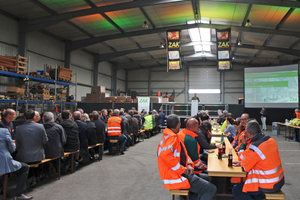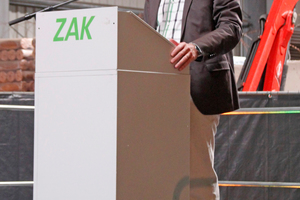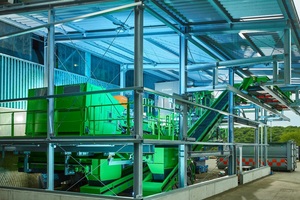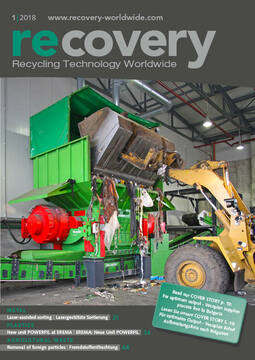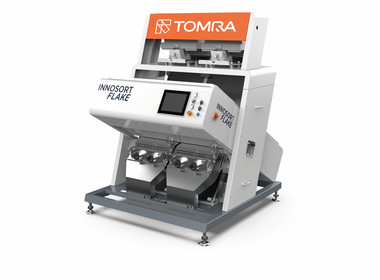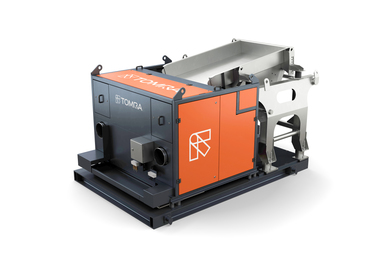Innovative sorting system commissioned
Tomra Sorting Recycling, based in Mülheim-Kärlich/Germany develops and builds sensor-based sorting systems for waste and metals recycling. The company has now successfully implemented its powerful near-infrared spectroscopy (NIR) technology also in the field of biowaste sorting.
Yields of biowaste have practically quintupled during the past twenty-five years. The biomass competence center operated by ZAK – Zentrale Abfallwirtschaft Kaiserslautern, (Center for Waste Management, Kaiserslautern) processes around 60 000 t of biowaste annually, using it to generate electricity, district heating and high-quality compost. The problem: biowaste contains on average around 3.5 % of extraneous materials, such as glass, plastics and metals, for example. Significantly too much, as the Interstate Waste Management Association (LAGA) recently lamented. In addition, the rules for the recovery of compost are also becoming noticeably stricter.
To keep pace with rising requirements, ZAK has now invested some 1.8 million € in sensor-based sorting technology supplied by Tomra Sorting (Mülheim-Kärlich). This innovative sorting system combines sensors for near infrared (NIR), electromagnetic metals detection (EM) and X-ray transmission (XRT) in a two-stage cleaning process in order to remove plastics, metals, glass, ceramics, stone and porcelain from contaminated biomass or contaminated compost. This permits even more efficient valorisation of biowaste and at the same time assures adherence to legally binding guideline figures. ZAK‘s innovative sorting system was officially inaugurated in the presence of numerous guests - including representatives from the state government and local administration, along with specialist colleagues – on 22 September 2017.
ZAK chairman Jan Deubig drew attention in his introductory speech to an increasing „waste-separation fatigue“ among the population, although the separate collection of biowaste is most certainly economically and ecologically rational. As Deubig affirmed, in no other sector can regional materials cycles be better closed. It should be noted that extraneous materials contents are also very heavily dependent not only on local charges systems, but also on population structure and time of year. „ZAK‘s new sorting system does not exempt citizens from their duty to collect biowaste conscientiously.“ Separate collection is both rational and vitally necessary, as the ZAK chairman emphasised. A further positive aspect, he said, should also be added to sustainable climate protection and conservation of resources: increasing the amounts of biowaste collected reduces non-recyclable waste, and thus achieves cost savings and benefits the ratepayer. As Deubig also knows, despite all the technology: „No one is better at sorting than the private household.“
Dr. Thomas Griese, Undersecretary of State in the Rhineland-Palatinate environmental ministry, also advocated new thinking: „Biowaste is a valuable resource. ZAK shows in exemplary fashion that separate collection of biowaste is worthwhile in more than one way: clever technology converts biowaste, on the one hand, into biogas, and permits generation of electricity and heat, while what remains can be used to make valuable compost.“ According to Dr. Thomas Griese, the new innovative sorting system, and also the center‘s environmental education activities, assist in preventing the contamination of biowaste, using this resource in the best possible way and creating the necessary awareness. This, he noted, relieves the burden on the environment, the climate, the municipalities and the ratepayers in equal measure. „It is very pleasing,“ Dr. Griese added, „that, statistically, the Rhineland-Palatinate achieves the best scores anywhere in Germany for collection of biowaste, at around 160 kg per inhabitant.“
Dr. Michael Kern, director of the „Witzenhausen Institute“ for waste, environment and energy, described the investment in this new sorting technology as „a first step“ in so-called „elimination of extraneous materials“. He, too, called for the active involvement of all participants – „both upstream and downstream the waste bin.“ The very start of the process, he affirmed, is avoidance of waste, but every citizen in the Federal Republic nonetheless still simply throws away an average of 80 kg of food every year. The fact that two thirds of this amount end up in the non-recyclable garbage, and not in the biowaste, provides at least an impression of the dilemma.
Finally, László Székely, development engineer at Tomra Sorting, explained the functional mechanism of the two optical sorting systems, Autosort and X-Tract. The biowaste is detected on the Autosort‘s conveyor belt by the sensors of the near-infrared (NIR) spectrometer and by electromagnetic sensors (EM). Individual valves are opened with spot-on accuracy when the sensor systems detect particles of plastic and/or metal requiring removal, and the material is then blown out by a jet of compressed air. The feed material is thus divided, correspondingly, into two fractions. The situation is similar using the broadband X-radiation of the X-Tract, which is generated by an electrical X-ray emitter. The radiation penetrates through the material to be sorted and is received in attenuated form by the X-ray camera. Any extraneous materials detected by the sensor system - such as glass, ceramics, stone or porcelain – are, again, ejected using compressed air.
And what happens to the „extraneous materials“ once they have been separated from the biowaste? Metals can be marketed, other disruptive elements can be incinerated in a waste-fuelled combined heat+power (CHP) plant, while coarse biogenic extraneous materials can be combusted in the on-site biomass-fuelled CHP plant. In the case of waste, too, it‘s always a question of what you make of it.
//www.tomra.com" target="_blank" >www.tomra.com:www.tomra.com

